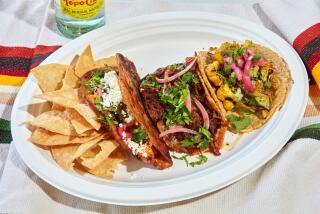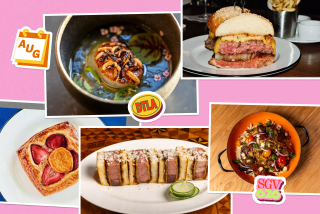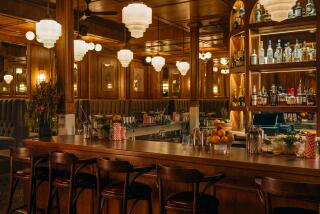Drive-Through Restaurants Not Convenient for All
With egg-and-bacon sandwiches available at dawn, tacos for lunch and cheeseburgers for midnight snacking, drive-through dining has never been more popular with Orange County commuters.
But for residents who live near some fast-food eateries, there’s little joy in all those McDonald’s Happy Meals. They complain about loudspeaker noise, traffic tie-ups, litter and even air pollution from idling cars that snake around pickup windows.
“You have people driving through there until 2 a.m., and you can hear them ordering their food,” said Jim Cook of Seal Beach, who lives two doors away from a Jack in the Box. “It gets to be annoying.”
Fearing similar situations in their neighborhoods, residents of Tustin, Newport Beach and other cities have battled new fast-food projects, and with some success.
Earlier this month, the Santa Ana City Council rejected McDonald’s Corp.’s application to open an outlet on North Main Street after nearby residents complained that the project would worsen traffic congestion.
And Newport Beach has imposed a temporary moratorium on new fast-food establishments on a stretch of Coast Highway while a committee drafts a redevelopment plan for the area, known as Mariners Mile.
Such outright rejection is rare. But in response to public concerns, officials have limited take-out window hours, required that drive-through lanes be designed to ease traffic flow and asked operators to make sure that discarded burger wrappers and cups are picked up.
The restaurant industry is fighting some of the new regulations, especially those that limit operating hours of existing businesses.
“Cities have the right to restrict zoning,” said Stanley R. Kyker, executive vice president of the California Restaurant Assn. “But if they reduce the hours of a business, that affects its viability as an investment.”
The association proposed state legislation earlier this year that would have required cities to compensate business owners whose operating hours are cut back. Though the bill died,Kyker said the association will continue to pursue the idea.
For fast-food chains, the stakes are high. Drive-through business now accounts for 40% to 50% of fast-food sales in Southern California, said Bob Sandelman, president of Sandelman & Associates, a fast-food marketing firm.
“If your restaurant doesn’t have a drive-through, there is the potential for losing business to ones that do,” Sandelman said.
As drive-throughs have proliferated, especially near residential areas, friction with neighbors has increased.
In Newport Beach, homeowners waged a six-month battle against McDonald’s and Taco Bell when the fast-food giants sought to build outlets in separate parts of the city. Both projects were eventually approved, but only after the companies agreed to “mitigation measures” aimed at reducing traffic, noise and litter.
The McDonald’s is now open on Newport Boulevard, and residents admit that their worst dreams of street gridlock and loitering teenagers have not come true.
The Taco Bell is now under construction in Mariners Mile, where several vacant commercial and restaurant properties have caught the eye of at least one other chain. The building moratorium, imposed last month by the City Council, aims to prevent the area from becoming a “fast-food row,” officials said.
Other neighborhoods’ concerns focus on late-night loitering, noise and crime. At the request of residents, Santa Ana adopted an ordinance in 1994 authorizing officials to review businesses that operate between midnight and 5 a.m., including fast-food outlets open 24 hours a day.
As part of the review, the Police Department recommended security measures such as improving outdoor lighting and removing large signs from windows, said Robyn Uptegraff, executive director of Santa Ana’s planning and building agency.
“For the most part, the businesses have implemented the conditions,” Uptegraff said.
On 8th Street in Seal Beach, however, homeowners such as Jim Cook remain frustrated.
After listening to hundreds of drive-through orders from the nearby Jack in the Box, Cook took action. When remodeling his house, Cook installed double-pane windows, 6-inch-thick walls and noise-blocking blinds on the side that faces the restaurant. The changes helped but did not eliminate the problem.
“When it gets hot in the summer, we open the windows on the other side of the house, and the noise echoes over,” Cook said. “Unless you live like a hermit, it’s still annoying.”
More to Read
Sign up for Essential California
The most important California stories and recommendations in your inbox every morning.
You may occasionally receive promotional content from the Los Angeles Times.











